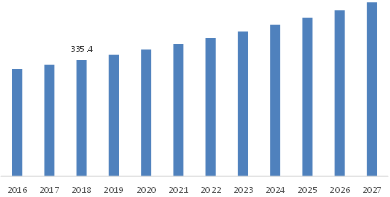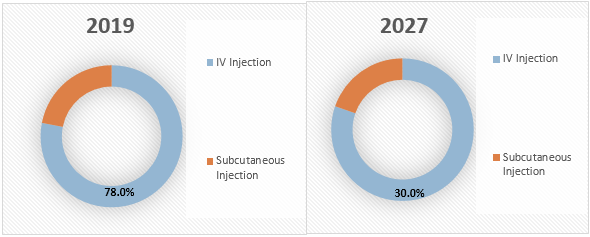Increasing number of people suffering from venous thromboembolism (VTE) is subsequently resulting in rising demand for heparin. For instance, according to the American Heart Association Inc. (AHA), the study published in Burden of Thrombosis in 2016 reports that majority of the data on the incidence and mortality of venous thromboembolism (VTE) comes from high-income countries, especially North America.
The U.S. unfractionated heparin market is expected to exhibit a CAGR of 4.5% over the forecast period (2019 – 2027).
Figure 1. Global U.S. Unfractionated Heparin Market Value (US$ Mn), by Region, 2018

To learn more about this report, Download Free Sample
Source: Coherent Market Insights Analysis (2019)
Favorable government regulations for heparin is expected to boost growth of the U.S. unfractionated heparin market
The global U.S. unfractionated heparin market is expected to gain significant traction, owing to favorable regulatory scenario. For instance, according to Medicare Prescription Source Benefit Manual: Chapter 6: 2016, Medicare Part- D states that source (extraction of heparin) used for heparin production must be used for a medically-accepted indication, which facilitates the diagnosis or treatment of illness or injury. Moreover, if a source works on medical equipment or devices and is not used for a medically-accepted indication of therapeutic value on the body, it cannot satisfy the definition of a Part D source. A heparin flush is not used to treat a patient for a medically-accepted indication, but rather to dissolve possible blood clots around an infusion line. Therefore, heparin’s use in this instance is not therapeutic but instead, is necessary to make durable medical equipment work. Heparin would therefore not be a Part D source when used in a heparin flush.
Moreover, in 2014, the American Society of Health-System Pharmacists (ASHP) issued the policy for safe and effective use of heparin in neonatal care, which was reviewed by the Council on Therapeutics and by the Board of Directors.
Figure 2. Global U.S. Unfractionated Heparin Market Share (%), by Product Type, 2019 and 2027

To learn more about this report, Download Free Sample
Source: Coherent Market Insights Analysis (2019)
Increasing cases of thrombosis and adoption of strategies such as mergers and collaborations by market players are expected to drive the market growth
The U.S. is expected to exhibit growth in the market, owing to increasing cases of deep-vein thrombosis (DVT). For instance, according to the National Center for Biotechnology Information (NCBI), the study published in 2018 reported that in the U.S., 200,000 people develop venous thrombosis annually and of those, 50,000 cases are complicated by pulmonary embolism. It is expected that the annual incidence of deep-vein thrombosis (DVT) is 80 cases per 100,000 with a prevalence of lower limb deep-vein thrombosis (DVT) in 1 case per 1,000 population.
The adoption of inorganic growth strategies by players is also boosting the market growth, For instance, in September 2019, Eisai and Nichi-Iko (parent company of Sagent Pharmaceuticals, Inc.) entered into a collaboration agreement. Under this agreement, Eisai and Nichi-Iko aims to enhance their pharmaceutical business in China by introducing high quality generic drugs in the country. Eisai will address a broader range of medical needs in China by further strengthening its China-based generic business.
Key Players
Major players operating in the global U.S. unfractionated heparin market include Pfizer, Inc., Sagent Pharmaceuticals, Inc., B. Braun Melsungen AG, Baxter International Inc., and Bayer AG.
Share
Share
Missing comfort of reading report in your local language? Find your preferred language :
Transform your Strategy with Exclusive Trending Reports :
Frequently Asked Questions
Select a License Type
Joining thousands of companies around the world committed to making the Excellent Business Solutions.
View All Our Clients